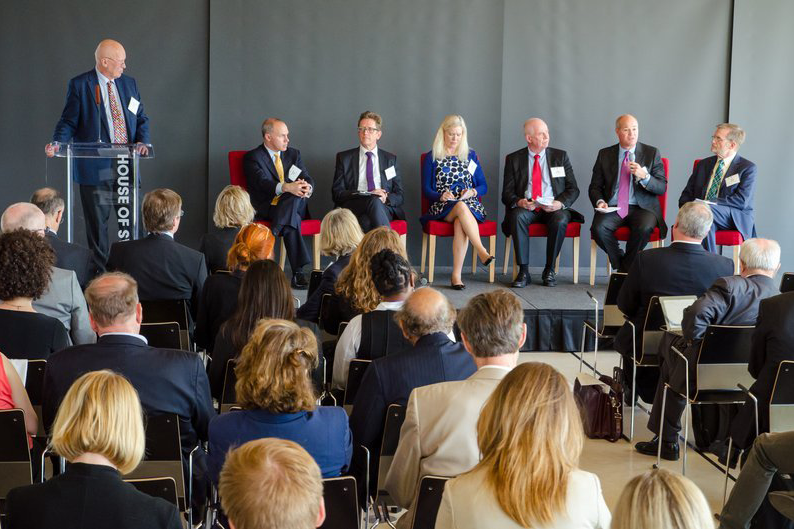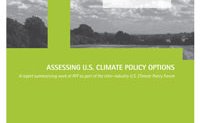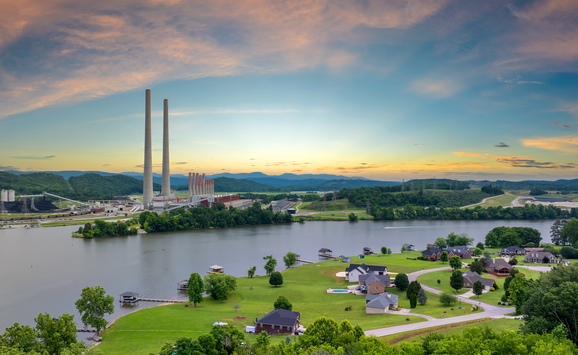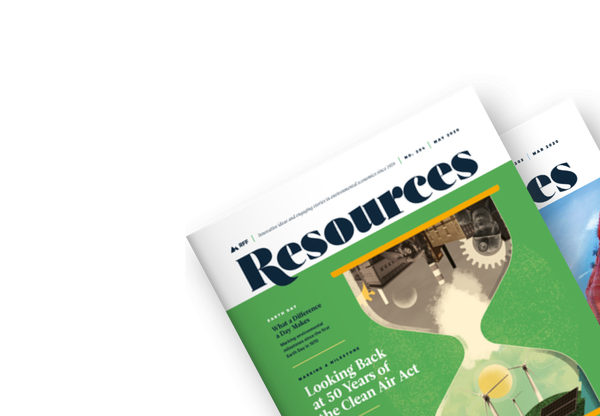Framing the next generation of climate and energy policies will involve the engagement of researchers, policymakers, and industry leaders to move the business conversation forward about climate policy. Resources for the Future is here for it.
Nearly 20 years ago, Resources for the Future (RFF) started an ambitious project to gather the most innovative corporations that were taking the threat of climate change seriously and aiming to be part of the solution.
To give a bit of a flavor of what life was like in 2006, let’s look at the headlines in Resources magazine from the Winter 2006 issue:
- Heating Subsidies Make a Difference in Offsetting Winter Mortality Rates Among the Poor and Elderly
- Voting for Conservation: What Is the American Electorate Revealing?
- Malaria Among African Children: Hope for Progress Against a Growing Menace
- Making Tough Choices: Hurricane Protection Planning After Katrina and Rita
- Examining China’s Mineral Consumption
Climate change, though embedded in the causes and consequences discussed among the articles, was not explicitly mentioned in these headlines. Significant US climate change mitigation and adaptation policies had not been enacted. Attempts to pass the Waxman-Markey bill were still three years away, and a decade would elapse before the United States signed the Paris Agreement. In 2006, climate policy was still open terrain.

Joseph E. Aldy (seated onstage, far left) and former Resources for the Future President and CEO Phil Sharp (seated onstage, far right) with other panelists and attendees, discussing the Paris Agreement at a workshop hosted by Resources for the Future in 2015.
Now, nearly 20 years later, it may be hard to keep track of all the climate policies that have been proposed, implemented, enacted, dissolved, or rolled back. The policy story around climate and energy over the past two years is overwhelming in its plot twists, and yet the environmental, health, and economic threats from the effects of climate change continue unabated.
A Bit of History
In 2006, RFF leaders saw an opportunity in the years ahead to really understand the wide range of potential policy responses and their costs. With the 2006 Climate Policy Forum and subsequent report in 2007, titled Assessing US Climate Policy Options, RFF made substantial progress toward a set of solutions for climate change. The aim was to provide policymakers and stakeholders with well-vetted, detailed options; important criteria for assessing the strengths and weaknesses of different approaches; and early identification of industrial and economic challenges across the options.
At RFF, the late Raymond J. Kopp and current President and CEO Billy Pizer, who was then a fellow, led the effort. In an article celebrating Kopp’s life, Pizer describes the project: “Over the course of 18 months, we provided a forum for business leaders across major sectors—electricity, fossil energy, transport, agriculture, heavy industry—to meet one another and learn about the various facets of climate policy,” Pizer writes. “The Climate Policy Forum helped these leaders understand their own issues and questions, target RFF research and expertise to answer those questions, and move the business conversation forward about climate policy.”
Pizer also remembers a genuine curiosity and interest by industry leaders to understand and inform the next generation of climate policies.
“There was a recognition by the companies that they should be prepared,” Pizer says.
David Raney, now retired, was an executive at Honda when the idea came up to gather corporate leaders together for the 2006 forum. “The confidence I had in RFF was the foundation,” Raney explains about joining RFF’s Business Leadership Council (then called the RFF Council). “RFF had enormous credibility on Capitol Hill and had earned respect inside Honda’s executive and engineering ranks. RFF had grown to respect the opportunity they had with Honda and its credibility and engineering prowess, honesty, and environmental leadership—we ‘liked’ each other. It was a good fit.”
Raney, an early cheerleader of the effort alongside Kopp, helped convince about 25 corporate executives to participate in a series of events. Raney emphasized that executives were open to joining these convenings because they were confident that the end product would be unbiased and informative, rather than an advocacy document. The diverse set of companies included automobile companies like Honda and Toyota, oil companies like Chevron and ExxonMobil, energy companies like Duke Energy and Southern Company, and financial institutions like Goldman Sachs. Goldman Sachs, the Doris Duke Charitable Foundation, and the William and Flora Hewlett Foundation supported the effort. (A full list of participants and funders can be found on page 202 of the 2007 report that came out of the original Climate Policy Forum.)
The aim was to provide policymakers and stakeholders with well-vetted, detailed options; important criteria for assessing the strengths and weaknesses of different approaches; and early identification of industrial and economic challenges across the options.
At the time, the political outlook was a 2008 presidential election that was anyone’s to win. With no incumbent running, the election was a fresh slate for either party to bring big ideas to the table, and there was bipartisan support for action. Even prior to nominees being named for the 2008 election, Democrat and Republican state governors and members of Congress had different ideas but a shared willingness to address climate change. Research focused on a variety of economy-wide policy solutions, including offsets, agriculture, international competitiveness, and the cost and pace of emissions reductions.
Raney, now retired, still has a copy of the 2007 report, and he shows the report to friends when they ask about what he did for a living. He calls it one of the “proud achievements” of his career. Raney says that the fact that it still stands the test of time is testament to the vision of the report. “We didn’t want it to end up as just another document on the shelf,” Raney says. “We wanted it to be a living document that government staffers refer to, and I think we did that.”
Joseph E. Aldy, a current RFF university fellow and the Teresa and John Heinz Professor of the Practice of Environmental Policy at Harvard Kennedy School, was a fellow at RFF between 2005 and 2009, authoring two issue briefs that were included in the 2007 report. He later served in the Obama White House as Special Assistant to the President for Energy and Environment. In the 2007 piece he authored, titled “Assessing the Costs of Regulatory Proposals for Reducing US Greenhouse Gas Emissions,” Aldy compares economic impacts associated with achieving different domestic emissions targets over the following two decades. In his issue brief “Competitiveness Impacts of Carbon Dioxide Pricing Policies on Manufacturing,” Aldy (along with authors Richard D. Morgenstern, Evan M. Herrnstadt, Mun Ho, and Pizer) present research about the likely impacts of carbon pricing on vulnerable industries.
One of the things Aldy remembers beyond the impact of his research is the importance of the opportunity to engage with industry leaders and policymakers around the work. “It was a great opportunity for me and, I would say, the first substantial opportunity I had to think about translating research and evidence for a business-community audience, which is not something you’re necessarily trained to do in a PhD program.”
Aldy also remembers that what made the work so well done and received was that the researchers iterated with industry leaders on what needed to be answered through research and evidence. “We had regular meetings with all the representatives from the business community, and we would take turns going through material that we had written and getting their feedback and then learning new questions to inform another batch of research and writing,” he recalls. “It was a two-way street, which was very important and very effective. We didn’t say, ‘Let’s imagine the audience and sit around in the fifth-floor conference room, make up what they need, and produce a report.’”

He also notes that, while the policy landscape for the future was quite unknown at the time due to open primaries for both major political parties, he still felt the conversation was well contained and focused on economics.
“What was important through this process was our focus on how to get the biggest bang for the buck, and our understanding of how the details of policy, design, and practice can influence that.”
Karen Palmer, a senior fellow and director of RFF’s Electric Power Program, and Dallas Burtraw, the Darius Gaskins Senior Fellow at RFF, also worked on the 2006 forum and 2007 report. Together they authored an issue brief, titled “The Electricity Sector and Climate Policy,” which outlines the special issues surrounding greenhouse gas regulations in the electricity sector, including both market-based and traditional regulatory options.
Palmer also acknowledges that the interaction between researchers and industry was invaluable, even if a little tricky at times. She says that the interface was critical to the integrity of the research and that the business voices weren’t pushing too far. “Kudos to Billy Pizer, primarily, who helped navigate the conversations between authors and participants.”
Burtraw noted that much of the research included in the 2007 report informed the American Clean Energy and Security Act of 2009, also known as the Waxman-Markey bill. The bill proposed a cap-and-trade system through which the federal government would set limits on total greenhouse gas emissions nationally. The House passage of the bill was the first time a house of the US Congress has approved a bill meant to curb carbon emissions. While the bill never reached the Senate and ultimately did not become law, it was a foundational movement toward climate change policies and regulations at all levels of government.
Burtraw noted that while the legislation didn’t pass in the United States, it did influence the design of climate policy subsequently. The idea of output-based allocation for carbon has since been embraced by states like California and by the European Union.
Convening in a New Context
Now, nearly 20 years from the last Climate Policy Forum, conversations are budding about whether the time is ripe for a new convening and research endeavor for a new slate of policy solutions, given the wildly changed context. In some ways, the current moment (including the recent repeals of massive decarbonization policies and an increasing interest in adaptation) presents a new carte blanche—but one informed by two decades of policy experimentation and a changed energy landscape. Now, business leaders also are dealing with unprecedented instability on a global level, with technological advances such as artificial intelligence and ongoing tariff wars with US allies and adversaries alike. Within the United States, coal use has declined, natural gas use has grown, and petroleum use could be slowing. There is a growing focus on nuclear and geothermal. Meanwhile, the landscape for policy discussions feels quite different. A new forum and its collaborative solutions-based thinking could inform future policymakers much like the first did, but in totally new ways.
“Industry is transforming,” Palmer notes. “We also know a lot more now than we did then. Everything should be on the table. A common understanding is still important, but it will be harder than ever. RFF can still steer the conversation, and we can all learn together.”
Pizer agrees. “One thing we battle against is people who say we don’t need more research and that we just need a communications strategy. I don’t think that’s right. It’s still important to have an objective understanding of what we’ve learned over the past decade, what new options look like, and whether and how new policy options affect important outcomes.”
Raney also cites the space and opportunity at hand to consider new industry voices in the conversation moving forward, such as technology companies and different types of financial actors, who have a huge stake in the future of energy and environmental economics. He also notes that many more nonprofit and philanthropic partners are in this space now than 20 years ago; considering their insights would be valuable. And while things have changed, he still feels confident that RFF is the group to lead. “I know of no other organization in the United States that has the credibility that RFF still has,” Raney says.
Now, nearly 20 years later, it may be hard to keep track of all the climate policies that have been proposed, implemented, enacted, dissolved, or rolled back.
For those who participated in the 2006 Climate Policy Forum and assembled the 2007 report, decarbonization and market-based tools continue to be on the table. If anything, many more policies across state and regional jurisdictions can motivate additional research questions and evidence. But they also acknowledge that the policy landscape has shifted dramatically, while the reality of climate impacts is now front and center. What could be debated in 2007 about the immediate impact of climate change seems much more present physically, with natural disasters and extreme weather affecting people’s lives and community infrastructure.
Burtraw and Aldy both note the need to understand the economics of mitigating climate change alongside the real cost of climate impacts. “Insurance markets will become a more prominent issue in the next several years,” Aldy says. “Deny climate change all you want; insurance markets are reacting to something.”
Raney also noted that much still needs to be understood about the economics of all energy options, including the opportunities and challenges around renewable energy and promising hydrogen-related innovations.
Important questions should be addressed about how to frame our next generation of climate and energy policies around the things that center political conversations, such as US competitiveness with China and energy affordability. Regardless of focus, leaders have the appetite to inform future policymakers and create a lasting positive impact for people, communities, and the economy.
“When I talk to people about restarting an open conversation about future climate policy, they are drawn to it because they want to feel hope,” Pizer says. “This is an opportunity to look toward something positive. Learning from everything that has happened, and what we now know, it is energizing to think about how we can take things forward and improve our environment and economy for the future.”






